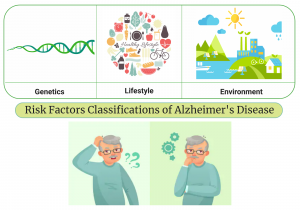7.1.2 – Risk Factors of Alzheimer’s Disease
Aside from the hallmarks seen on the cellular and molecular level, there are also behavioural symptoms observed in individuals suffering from AD which includes psychosis, impaired movement, apathy, mental instabilities as well as having difficulties in sleep. These symptoms can sometimes be experienced by individuals without AD, but the rate of occurrence for these symptoms in AD individuals is relatively fast compared to healthy individuals, therefore it can be quickly recognizable and differentiated from healthy individuals. Studies have suspected that the significant alleviation of these symptoms in AD patients may be related to dysfunctions in the neurotransmitter transfer mechanisms due to the blockage of neuronal impulse by plaques and neurofibrillary tangles.
As discussed in the previous section, AD is a neurodegenerative disease, meaning that it occurs due to damage of neuronal cells. However, all cells, including the brain cells undergo progressive damage with increasing age. This may explain why most of the individuals that are diagnosed with AD are people with the age of approximately 50 years or older. However, the rate of degeneration of neurons can vary according to the individual. A faster rate of degeneration may predispose younger individuals to develop AD early in life. The occurrences of the cellular and molecular hallmarks are affected by the expressions of apoE alleles hence making the disease hereditary, but the degeneration of cells may also be associated with the individual lifestyle and their environmental exposure.

One of the possible substances that are widely used in daily life and has been recognized to increase an individual’s risk to AD are aluminum ions. Aluminum is broadly used in making cookware, utensils, food containers and other household items. The dependence of human livelihood on aluminum-based products is highly worrying because it means that the elements of daily life for many people are actually threatening their health. Even though aluminum ions are needed in the human body to promote mitosis of epithelial cells, excessive intake of these ions (through consuming food) can harm the cellular processes such as protein synthesis. In addition to the degradation of neurons, the cells are unable to repair and produce new neurons, further increasing the rate of amyloid and tangle accumulation.
Besides the genetic and environmental exposure, an individual’s lifestyle also poses a risk in the development of Alzheimer’s Disease. To counter this, individuals are highly encouraged to exercise to increase muscle strength, eat healthy to gain enough nutrients, and also to always challenge our minds to increase neuronal connections. By exercising, we are allowing our cells to be used more which helps with repair of any wear and tear as well as increases in the rate of impulse transfer between neurons. Being inactive and having a sedentary lifestyle with a poor nutritional diet poses a risk that may reduce the ability of cells to repair themselves and also reduce connections between neurons.
